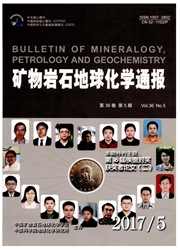

 中文摘要:
中文摘要:
高U锆石的离子探针U-Pb分析中存在随U含量升高而表现更老的现象,称之为"高U效应"。本文尝试性总结了UPb衰变过程可造成锆石晶格的损伤、后期热愈合作用造成损伤锆石的结构变化、离子探针Pb/U离子化效率差异等因素,认为"高U效应"主要源于损伤锆石处于微尺度的混晶状态(晶态Zr SiO_4、ZrO_2和无定形SiO_2),放射成因Pb容易进入无定性SiO_2,而U进入ZrO_2,造成Pb/U离子化效率差与锆石情况不同。统计发现,高U锆石不仅表现为偏老的"高U效应",还受损伤导致Pb丢失的影响,结果存在较大不确定性,不适宜离子探针精确U-Pb定年,应在测试选点过程中避免,或选用其他矿物,如独居石、磷钇矿、榍石等代替。
 英文摘要:
英文摘要:
"High-U effect"is used to describe a phenomenon during SIMS zircon U-Pb dating that the apparent Pb / U ages of high-U zircons show positive correlation with their high U contents. In this paper,based on reviewing many investigations on radiogenic damage effect on the lattice of zircons by the U-Pb decay,and the structural change of damaged zircon caused by the thermal annealing effect,and the efficiency differences between Pb and U ionization of zircons by using SIMS,it is believed that the ″High-U effect″ could be mainly caused by the mixture state of crystalline crystals of Zr SiO_4,ZrO_2 and amorphous state of SiO_2 for the radiogenic damaged zircons,as the radiogenic Pb is in favor to combine with the amorphous SiO_2,while the U is in favor to enter into the lattice of ZrO_2,resulting in the efficiency differences between Pb and U ionization during SIMS analysis. In addition,based on the statistics,the high-U zircon not only has "High-U effect",but also Pb-depletion effect due to the radiogenic damage,resulting in the relatively big uncertainties for the U-Pb dating results. Therefore,it is believed that the high-U zircon is not suitable and should be avoided for precise SIMS U-Pb dating. It is recommended that some other minerals,such as monazite,xenotime,and titanite,could be good substitutes of the high U zircon for SIMS U-Pb dating.
 同期刊论文项目
同期刊论文项目
 同项目期刊论文
同项目期刊论文
 Age determination of nephrite by in-situ SIMS U-Pb dating syngenetic titanite: A case study of the n
Age determination of nephrite by in-situ SIMS U-Pb dating syngenetic titanite: A case study of the n Monazite and xenotime U-Th-Pb geochronology by ion microprobe: dating highly fractionated granites a
Monazite and xenotime U-Th-Pb geochronology by ion microprobe: dating highly fractionated granites a 期刊信息
期刊信息
